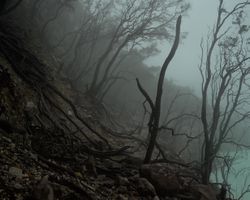articles
First, the Forests
Nature reorganized
16th century, 20th century, carte, D'abord les forêts, Dan Handel, dessin, drawing, États-Unis, First the Forests, forest, foresterie, forestry, forêt, Inde, India, Italie, Italy, map, photographie, photography, Programme pour jeune commissaire, United States, Venice, Venise, XVIe siècle, XXe siècle, Young Curator Program
28 August 2012
Nature reorganized
Architecture as Evidence
Architecture as Evidence presents a set of materials gathered during a forensic analysis of the architecture of Auschwitz. It assembles plaster casts of blueprints, letters, contractor bills, and photographs, as well as two reconstructed monuments (a gas column and a gas-tight hatch), which together provide tangible evidence that Auschwitz was designed by its architects(...)
Octagonal gallery
16 June 2016 to 11 September 2016
Architecture as Evidence
Actions:
Description:
Architecture as Evidence presents a set of materials gathered during a forensic analysis of the architecture of Auschwitz. It assembles plaster casts of blueprints, letters, contractor bills, and photographs, as well as two reconstructed monuments (a gas column and a gas-tight hatch), which together provide tangible evidence that Auschwitz was designed by its architects(...)
Octagonal gallery
The exhibition addresses a central and timely aspect of the work of Carlo Scarpa: its distinctive approach to contending with the layers of history that mark the fabric of a city and a building. In addressing Scarpa’s ability to weave new work into, and often out of, the disparate fragments of the old, Carlo Scarpa, Architect: Intervening with History begins to unravel(...)
Main galleries
26 May 1999 to 31 October 1999
Carlo Scarpa, Architect: Intervening with History
Actions:
Description:
The exhibition addresses a central and timely aspect of the work of Carlo Scarpa: its distinctive approach to contending with the layers of history that mark the fabric of a city and a building. In addressing Scarpa’s ability to weave new work into, and often out of, the disparate fragments of the old, Carlo Scarpa, Architect: Intervening with History begins to unravel(...)
Main galleries
*Cities of Artificial Excavation: The Work of Peter Eisenman, 1978–1988* explores how American architect and writer Peter Eisenman questioned the concept of “site,” and demonstrates the importance of drawing and modelmaking in generating his ideas. The exhibition reveals the richness and complexity of the design process by looking carefully at Eisenman’s drawings and(...)
Main galleries
2 March 1994 to 19 June 1994
Cities of Artificial Excavation: The Work of Peter Eisenman, 1978-1988
Actions:
Description:
*Cities of Artificial Excavation: The Work of Peter Eisenman, 1978–1988* explores how American architect and writer Peter Eisenman questioned the concept of “site,” and demonstrates the importance of drawing and modelmaking in generating his ideas. The exhibition reveals the richness and complexity of the design process by looking carefully at Eisenman’s drawings and(...)
Main galleries
Celebrating the opening of the CCAs new building, Canadian Centre for Architecture: Building and Gardens reveals the potential of a museum of architecture as a statement: about the nature of the works it collects and exhibits; about its role in the life of a culture or a city; and about architecture itself. Both the restoration of the nineteenth-century Shaughnessy House(...)
Octagonal gallery
7 May 1989 to 25 March 1990
Canadian Centre for Architecture: Building and Gardens
Actions:
Description:
Celebrating the opening of the CCAs new building, Canadian Centre for Architecture: Building and Gardens reveals the potential of a museum of architecture as a statement: about the nature of the works it collects and exhibits; about its role in the life of a culture or a city; and about architecture itself. Both the restoration of the nineteenth-century Shaughnessy House(...)
Octagonal gallery
Bas Princen: Volcano Walks
In this artist’s talk, Bas Princen will discuss the current status of the 17 Volcanoes project and explore the resonances between the works of Franz Wilhelm Junghuhn, works by early-twentieth-century Dutch photographers in Java (like van Nieuwenhuis), and his own practice. Although discovering new places seems impossible today, the talk takes as a point of departure the(...)
15 October 2016, 3pm
Bas Princen: Volcano Walks
Actions:
Description:
In this artist’s talk, Bas Princen will discuss the current status of the 17 Volcanoes project and explore the resonances between the works of Franz Wilhelm Junghuhn, works by early-twentieth-century Dutch photographers in Java (like van Nieuwenhuis), and his own practice. Although discovering new places seems impossible today, the talk takes as a point of departure the(...)
research
Visiting Scholars 2012
Elke Krasny, Akademie der bildenden Künste Wien, Vienna, Austria Topic: Shim-Sutcliffe: Crafting Architecture. A Monograph as Critical Reflection Shannon Mattern, The New School, New York, United States Topic: Urban Media Archaeology. Communication Infrastructure and Material Cities Manfredo Nicolis di Robilant, Politecnico di Torino, Turin, Italy Topic: Utility versus(...)
2 April 2012 to 31 August 2012
Visiting Scholars 2012
Actions:
Description:
Elke Krasny, Akademie der bildenden Künste Wien, Vienna, Austria Topic: Shim-Sutcliffe: Crafting Architecture. A Monograph as Critical Reflection Shannon Mattern, The New School, New York, United States Topic: Urban Media Archaeology. Communication Infrastructure and Material Cities Manfredo Nicolis di Robilant, Politecnico di Torino, Turin, Italy Topic: Utility versus(...)
research
2 April 2012 to
31 August 2012
research
Visiting Scholars 2002–2003
Chiara Baglione, IUAV-Istituto Universitario di Archittetura di Venezia, Venice, Italy Topic: Becoming an Architect in the Rome of Urban VIII: Architectural Training and Early Works of Pietro da Cortona Laurent Baridon, Université Marc Bloch, Strasbourg, France Topic: Dinocrate ou l’architecte en représentation Martin Bressani, McGill University, Montreal,(...)
5 January 2003 to 31 August 2003
Visiting Scholars 2002–2003
Actions:
Description:
Chiara Baglione, IUAV-Istituto Universitario di Archittetura di Venezia, Venice, Italy Topic: Becoming an Architect in the Rome of Urban VIII: Architectural Training and Early Works of Pietro da Cortona Laurent Baridon, Université Marc Bloch, Strasbourg, France Topic: Dinocrate ou l’architecte en représentation Martin Bressani, McGill University, Montreal,(...)
research
5 January 2003 to
31 August 2003
Learning from... Rome
Filmmaker and photographer Armin Linke reveals the societal changes, cultural complexities, and beauty of contemporary Rome through two short films and architectural photographs from his archives. The first film focuses on a moment of natural choreography as some 100,000 starlings fly against the backdrop of the city of Rome. Linke presents a selection of photographs,(...)
Paul Desmarais Theatre
5 March 2009
Learning from... Rome
Actions:
Description:
Filmmaker and photographer Armin Linke reveals the societal changes, cultural complexities, and beauty of contemporary Rome through two short films and architectural photographs from his archives. The first film focuses on a moment of natural choreography as some 100,000 starlings fly against the backdrop of the city of Rome. Linke presents a selection of photographs,(...)
Paul Desmarais Theatre
Learning from… São Paulo
Angelo Bucci, architect and professor at the University of São Paulo, Brazil, addresses the violence and changing environment of São Paulo in search of new urban forms. São Paulo’s urban violence can be understood as ruining the experience of the city and, as a result, the purpose of the architect’s work. The lecture examines São Paulo not as a static object, but as an(...)
22 April 2010
Learning from… São Paulo
Actions:
Description:
Angelo Bucci, architect and professor at the University of São Paulo, Brazil, addresses the violence and changing environment of São Paulo in search of new urban forms. São Paulo’s urban violence can be understood as ruining the experience of the city and, as a result, the purpose of the architect’s work. The lecture examines São Paulo not as a static object, but as an(...)







